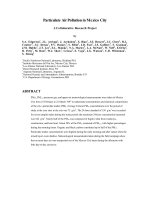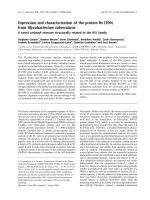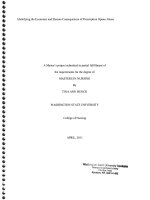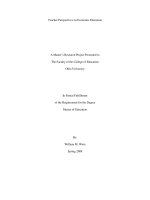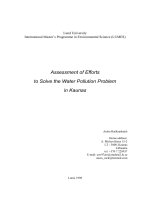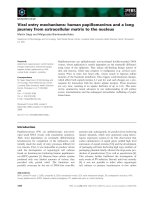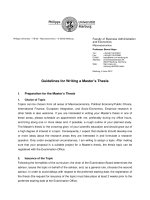A Master’s Research Project Presented to The Faculty of the College of Education Ohio University pdf
Bạn đang xem bản rút gọn của tài liệu. Xem và tải ngay bản đầy đủ của tài liệu tại đây (91.77 KB, 42 trang )
Teacher Perspectives on Economic Education
A Master’s Research Project Presented to
The Faculty of the College of Education
Ohio University
In Partial Fulfillment
of the Requirement for the Degree
Master of Education
By
William M. Wion
Spring 2008
The Master’s Research Project has been approved
for the department of Teacher Education
________________________________
Frans Doppen, Assistant Professor, Social Studies Education
__________________________________
Ginger Weade, Professor and Interim Chair of the Department of Teacher Education
i
TABLE OF CONTENTS
Chapter One: Introduction…………………………………………………………1
Statement of Problem……………………………………………………….2
Research Question…………………………………………………………..3
Purpose and Significance of Study…..……………………………………..3
Limitations………………………………………………………………….3
Methodology………………………………………………………………..4
Organization of Study………………………………………………………4
Chapter Two: Review of the Literature………………………………………….....6
The Collaborative Problem Solving (CPS) Approach……………………....7
Service Learning Approach………………………………………………....8
An Interactive (Role Playing) Simulation Approach……………………....10
The Inverted Classroom Approach…………………………………….......11
Experiments, Demonstrations, or Dramatizations…………………………12
Technologies Based Teaching Methodologies…………………………….13
Lecturing plus Student Centered Technologies……………………………15
Summary…………………………………………………………………...16
Chapter Three: Methods…………………………………………………………..17
Participants………………………………………………………………....17
Data Collection…………………………………………………………….19
Data Analysis………………………………………………………………20
Chapter Four: Findings……………………………………………………………22
Questionnaire………………………………………………………………22
ii
Summary…………………………………………………………………...30
Chapter Five: Conclusions and Recommendations……………………………….32
Conclusions………………………………………………………………...32
Recommendations……………………………………………………….....33
Appendix A………………………………………………………………………...35
Questionnaire………………………………………………………………35
References………………………………………………………………………….37
1
CHAPTER ONE
INTODUCTION
Economic education is extremely important because it is vital to the future health
of our nation’s economy. The purpose of Economic education is to create responsible
citizens and effective decision-makers. According to James Calderwood in the article
“What is Economic Education,” these two qualities require students to be able to
understand and make reasoned judgments about major economic questions facing society
and themselves as members of that society (Calderwood, 1981, p.33). Many of the
current economic problems that we face could be resolved if students are required to
complete a course in Economics and become economically literate.
Economic education is a very crucial subject that many of our nation’s schools
tend to overlook. According to a survey compiled by the National Council of Economic
Education titled “Survey of the States Economic and Personal Finance Education in Our
Nation’s School 2007,” there is still much that needs to be done in terms of implementing
Economic education into our nation’s schools. Currently, there are 49 states as well as
the District of Columbia that include Economics in their standards. Iowa and Rhode
Island are the only two states that do not include Economics in their standards. Of the 49
states, 41 states (83% of those with standards) require implementation of Economic
standards. Seventeen of those states (35%) require an Economic course to be offered.
There are just 17 states that require students to take an Economics course as a
requirement for graduation. Only 22 states require testing of student’s knowledge in
Economics and this is three fewer than in 2004 (National Council of Economic Education,
2007). It is very clear that progress has been made in the teaching of Economics over the
2
past several years, but much more work still needs to take place in emphasizing
Economics in our K-12 curriculum. Steps that need to be taken include; requiring
separate, stand-alone courses in these subjects as part of high school graduation
requirements, and testing student knowledge levels (National Council of Economic
Education, 2007).
One of the current problems with economic education is the strategies teachers
use to teach the subject. The majority of teachers are stuck on traditional methods that
have been in practice for many years. A specific example would be the chalk and talk
method, which is defined as a traditional method of education in which the teacher
addresses the students and uses the blackboard to provide examples or illustrations
(Encarta, 2007). Another example that is very similar to chalk and talk is lecture, another
method of direct instruction. Many students who take Economics classes get very bored
and uninterested in the material taught because of these outdated teaching methods. If
teachers were able to use more effective methods in the Economics courses they teach,
their students would be able to better comprehend the information making them better
citizens of not only the United States but the world as well.
Statement of Problem
Economic education is a growing subject in secondary education. The current
teaching strategies that are implemented by economic teachers at the high school level
are outdated and do not pertain to the ways in which students best comprehend economic
content.
3
Research Question
Based on the statement of the problem, this master’s research project seeks to
answer the following research questions:
1. What is the purpose and importance of Economic education?
2. What teaching strategies does the literature suggest should be implemented by
teachers that teach Economics courses and will best benefit the ways in which
students learn economics?
Purpose and Significance of Study
The purpose of this study is to gain a better understanding of the effective
teaching strategies that can be used in the Economics classroom and that will ultimately
help students better comprehend the economic content through their different learning
styles. The significance of this paper is that it addresses a serious and applicable issue in
Economic education today. Through this review, Economic teachers will be able to gain
an understanding of several different teaching strategies and how these strategies pertain
to student’s different learning styles. Educators will be able to better plan their lessons
according to the teaching strategies that benefit their students learning styles and that
pertain to the content being presented.
Limitations
Major limiting factors for this master’s research project are:
1. Much of the research done on Economic education teaching strategies has
been done at the College Level. At the secondary level, the research is limited.
2. Articles found through various electronic search engines was only used if they
were available on-line or at the main branch of the Alden Library.
4
3. The participants selected for the research study filled out an interview
questionnaire that was sent to them via email. They were not interviewed
orally. This is considered a limitation because in the event of a
misunderstanding, participants could not immediately be asked to clarify.
Instead, follow-up emails; asking for further insight, greater detail, and/or
clarification, were sent to participants when necessary.
Methodology
The methodology for this research project consisted of a literature review using
the electronic sources provided through the Alden Library at Ohio University. The
primary search engines included JSTOR, Educational Resources Information Center
Search Engine (ERIC), Academic Search Complete, and Google Scholar. The search
focused on the key words “Economic education,” “teaching strategies,” “teaching
methodologies,” and “high school economics.” The search was then limited to those
articles that addressed Economic education at the secondary level and those that were
available in full text electronically or in print at Alden Library. Next, abstracts were
reviewed to narrow down the literature and to identify the most relevant.
Organization of Study
Chapter One of this study includes an introduction to Economic education. The
main problem and the research questions are outlined. The purpose and significance of
the study, along with the limitations are also included in this chapter.
Chapter Two presents a review of the literature conducted for this study. Themes
will be identified and supported by finding in the literature.
5
Chapter Three includes a comprehensive summary of the research, and an
analysis of the findings. Any limitations that played a role will also be discussed.
Chapter Four summarizes the previous three chapters and offers conclusions and
recommendations for further study.
6
CHAPTER TWO
REVIEW OF THE LITERATURE
Economic education serves the purpose of educating students so that they will
become responsible citizens and effective decision-makers in society. Economic
education provides students with the real-life skills they need in order to succeed.
Ultimately, economics will educate students so that they will be able to think and choose
responsibly as consumers, savers, investors, citizens, members of the workforce, and
effective participants in a global economy (NCEE, 2008). As the President of the Federal
Reserve Bank of Philadelphia, Anthony Santomero, states “Economic and financial
education is the best investment we can make to strengthen our nation’s economy”
(Santomero, 2003).
Prior to looking at the many different teaching strategies, we must first look at
why educators struggle with the teaching of economics through the many different
strategies available. First and foremost, educators aren’t adequately educated themselves
in terms of economic education. Social studies educators are generally the ones who are
responsible for teaching high school economics courses and the typical social studies
educator on average has only completed four to eight credit hours of economics course
work. This represents no more than seven percent of the total social science hours
required for certification (Joshi & Marri, 2006). How can we expect these educators to
effectively teach our youth the knowledgeable skills and content of economics when they
in fact do not have the requisite knowledge and skills themselves?
7
To overcome this, economics education must become a priority in secondary
social studies preservice teacher education programs with the end goal of producing
active, economically literate citizens (Joshi & Marri, 2006). Social studies educators
should be required or take responsibility upon themselves to attend workshops in order to
enhance and update their knowledge and skills in effectively teaching economics and to
become aware of new teaching techniques available. There is a wide variety of
workshops available at the various Centers of Economic Education located at universities,
which are affiliated with the National Council of Economic Education (Joshi & Marri,
2006).
Researchers have looked at many different teaching strategies that are
implemented in the economics classroom. It is obvious that every student has a particular
learning style from which he or she benefits most. With that said, one specific teaching
strategy should not be the sole means of presenting the information to the students in the
classroom. Rather teachers should utilize a variety of teaching methods. This allows the
students to be actively involved in several different ways without boring them with the
same repetitive routine as well as focusing on every student’s learning style. This has
proven to be a successful teaching strategy (Wentland, 2004).
The Collaborative Problem Solving (CPS) Approach
According to Wentland (2004) there are two ways to try to improve how
economic information is communicated to students: problem-based learning as well
collaborative learning. Problem-based learning deviates from more conventional
instructional strategies by reorienting traditional teacher-student interaction toward active,
self-directed learning by the student, rather than didactic, teacher-directed instruction
8
(Maxwell, Mergendoller, & Bellisimo, 2005). In problem-based learning, students
formulate and pursue their own learning objectives by researching a situation, developing
appropriate questions, and producing their own solutions to the problem. Teachers coach
students with suggestions for further study or inquiry but do not assign predetermined
learning activities (Maxwell et al., 2005).
According to Smith and MacGregor (1992), collaborative learning is an umbrella
term for a variety of educational approaches involving joint intellectual efforts by
students, or students and teachers together. Usually students are working in groups of
two or more, mutually searching for understanding, solutions, or meanings, or creating a
product (Smith & MacGregor, 1992). Collaborative learning activities vary widely, but
most center on students’ exploration or application of the course material, not simply the
teacher’s presentation or explication of it (Smith & MacGregor, 1992). Collaborative
learning fosters the developments of improved communications and teamwork skills.
Together, the two components, problem-based learning and collaborative learning,
make up the collaborative problem solving approach to teaching. Through the
implementation of this strategy students will be forced to be actively involved, work with
others to comprehend the information, and think critically about the information.
Service-Learning Approach
Service-learning is a method of experiential learning that links the classroom with
the local community. Service-learning can be viewed as a project for the economics
classroom and when administered properly, will help student’s recognize links between
experience and learning while enhancing their problem solving and creative/critical
thinking skills. The service learning project requires students to volunteer in a local
9
business and then relate their experiences to the educational theories they learn in the
classroom. Throughout the service-learning project, students are expected to identify
economic issues, explore economic theories, and provide evidence relating their
experiences to these economic theories (McGoldrick, 1998). Service-learning is an ideal
approach to active learning.
A more specific example of the service learning project is described by
McGoldrick (1998) describes service-learning in an Economics course.
Students volunteer to provide services for a community organization and through
these experiences they discover economic principles at work in the real world.
Example of the economic issues that may be developed in this way include
externalities, price ceilings and floors, unemployment, poverty, and many other
policy issues. Writing assignments and class discussions promote the sharing of
observations and reflections, which students are then responsible for linking with
the theories presented over the entire course. Finally, students are asked to share
these experiences with their peers through group or individual presentations. This
step allows students to recognize the applications of these theories and principles
to various situations, completing the cycle of learning” (p. 367).
Service learning is an ideal active approach to learning economics in the high
school classroom. Research on service learning in high school economics is very limited
and much of it has been committed to college level economics courses. This is obvious
for a number of reasons; it depends heavily on the school and community resources
available, length of the economic course, and students’ availability to volunteer their time.
If the service learning approach is not suitable for certain high school economics
10
classrooms, it does not have to be implemented in its entirety. Adjustments could be
made so that it can be applicable. For example, businesses can be contacted and if
interested, they can provide the necessary information so that students can do everything
within the classroom. The key concept of service learning is learning through the linkages
of the classroom and the local community.
An Interactive (Role Play) Simulation Approach
The interactive (role play) simulation approach engages students directly in the
economic process, so that their understanding of economic principles is based on, or
reinforced by, their own experience, observations and analysis. By placing students in a
market situation and asking them to interpret their behavior and observations and to
analyze the market results, they are able to move from abstraction to reality (Myron,
1970). This teaching approach can be implemented in the classroom through the use of
the many available economic games/simulations.
Examples of economic games that have proven to be beneficial include; “The
Summit of the Americas,” and “The Stock Market Game.” “The Summit of the
Americas” is a macroeconomic behavioral game in which students act as trade
representatives negotiating trade agreements on behalf of their respective countries. The
simulation challenges students to process information efficiently and quickly, to apply
economic analysis, to sharpen decision-making skills, and to improve their negotiation
skills with the ultimate goal of developing and implementing a plan to enhance their
country’s economic and political well being (Wentland, 2004). “The Stock Market
Game” gives students the chance to invest a hypothetical $100,000 in an online portfolio.
While students think they are just playing a game, they are actually learning economic
11
and financial concepts they will use for the rest of their lives. This game helps teach and
reinforce the essential skills of critical thinking, decision-making, cooperation and
communication, and independent research (Stock Market, 2007).
An interactive (role play) simulation approach enables a learning experience that
can help students understand basic economic concepts through their own involvement in
a market. Its strengths are derived from the fact that the students learn by analyzing their
own behavior and observations in a situation that taps their competitive drive (Myron,
1970). This approach, through the use of role play and simulations/economic games, is a
powerful method that actively engages students in the learning process, taps into
students’ interests, and forces them to participate as opposed to letting students be passive
recipients.
The Inverted Classroom Approach
The inverted classroom approach means that events that have traditionally taken
place inside the classroom can now take place outside the classroom and vice versa. The
use of learning technologies, particularly multimedia, provides new opportunities for
students to learn. For example, the use of the World Wide Web and multimedia
computers enables students to view lectures outside the classroom, whereas homework
assignments can be done in class, in groups. The general principle of this method is to
provide a menu of options for the students to use in learning (Lage, Platt, & Teglia, 2000).
This approach makes students responsible for their own learning. Students would
be expected to come to class prepared by viewing and/or listening to a lecture or reading
assigned material prior to class, so when they do come to class, they will be able to
discuss the relevant material. This allows class time to be used for open ended
12
discussions, experiments, demonstrations, and group activities which would ultimately
help student gain a better understanding of the material.
One of the strengths of this method is that it provides an opportunity for better
student-teacher communication. This interaction is beneficial in two ways: the student is
able to clear up any confusion immediately, and the instructor is able to monitor
performance and comprehension (Lage, Platt, & Teglia, 2000). A communication or
discussion board could be set up on the school’s website or the teacher’s website so that
communication can easily be extended outside the classroom and school.
With the many different learning styles students display, the inverted classroom
approach implements a strategy of teaching that engages a wide variety of learners. It
allows students of all learning styles to use a method or methods that best suit them. This
approach will give the teacher more time within class to spend on activates that will
actively involve the students as opposed spending it on lectures. Overall, the inverted
classroom method allows instructors to present options that appeal to most learning styles
while still maintaining control over course coverage and content.
Experiments, Demonstrations, or Dramatizations
Experiments, demonstrations, or dramatizations offer teachers another teaching
method that can effectively help communicate economic concepts to students.
Experiments and demonstrations provide students with an opportunity to see the
economic principles in action. A simple experiment might consist of holding an auction
for a can of cola. Bidding could begin at five cents and increased in five-cent increments;
count would be taken of how many people wanted to buy the can at each price.
13
Eventually, the can would be sold to the only student still willing to pay. A simple graph
of the data would give the students their first demand curve (Lage, Platt, & Treglia, 2000).
Experiments, demonstrations, or dramatizations can be utilized by teachers as an
effective teaching strategy in any economics classroom. By using this method, teachers
can turn the classroom into a laboratory format with the purpose of providing a more
active learning environment in which the students can be meaningfully engaged by the
material, with other students, and with the instructor (Cardell, Fort, Joerding, Inaba,
Lamoreaux, Rosenman, et al., 1996).
Technology Based Teaching Methodologies
Many of the previously mentioned teaching methods have either
incorporated the use of technology in one way or another or could easily incorporate it, if
not already. With the many changes that have occurred in instructional technology, in
particular the development of the Internet and the World Wide Web, teachers have been
provided with new opportunities that can improve the way they teach and the way
students learn. Incorporating technology into the classroom, even with traditional
teaching methods, can enhance learning for students with a variety of learning styles, and
at the same time make economic content more relevant, more interesting and more fun
for teachers and students.
Simkins (1999) stresses the importance of utilizing technology, such as the
Internet, in the classroom and ways that it can be beneficial to teachers and students.
The Internet is a rich source of economic news, data, and information that
can make economics relevant and understandable for students in ways
that lectures and textbooks alone cannot. Instructors can use up-to-minute
14
data and examples to illustrate economic concepts and provide additional
sources of information from across the world. Students can view news
clips, listen to speeches, and access on-line economics resources from a
variety of Web sources. These resources provide the basis for a wide
variety of active-learning exercises. For example, students can use
information from the web to compare the economic and political
characteristics of various countries, to develop a Web-based magazine (ezine) analyze current economic policy issues, or to make economic
predictions based on economic theory and current economic conditions.
These types of activities directly involve students in the learning process
and make economics come alive, promoting broader interests in
economics and provide a richer learning experience that traditional
teaching methods can (p. 279).
The Internet is not the only technological tool that can account for effective
teaching methods. There are several technology-based teaching/learning approaches that
can be utilized in economic education which include: videotapes, DVDs, films, television
programs, simulation programs such as games, electronic textbooks, and class discussion
boards (Wentland, 2004). It is the teacher’s responsibility to make sure that whatever
teaching method he or she uses, in terms of technology, actively involves the students and
enhances their learning and comprehension of economics material.
Overall, technology can be used to assist teachers in their attempts to encourage
and motivate students to become active participants in the learning process. The Internet,
along with many other technological resources, provides new opportunities for improving
15
teaching and learning in economics. Educators are faced with the challenge of coverage
and depth of material while enhancing the classroom experience with meaningful in-class
experiences; technology is just the key to help them accomplish this.
Lecturing plus Student Centered Activities
Lecturing is a teaching strategy that does not seem to be the most beneficial for
the many different learning styles students have. It puts the students in a passive role by
forcing them to sit and write down notes on the topic that the teacher lectures on.
However, when lecturing is combined with student-centered activities, while still perhaps
not the most desired approach, it can be an effective teaching strategy for the economics
classroom.
The student participation component has many variations including selecting
students at random during a lecture and then asking them to paraphrase or comment on
what was just stated (Wentland, 2004). Another example would be to organize students
into groups in order to orally review the content of each lecture. Each group would then
submit summary write-ups that can ultimately be compiled into a course review
document (Wentland, 2004). A third example would be asking students to write a
“minute-paper” which is assigned during the last minutes of class. Each student would
be required to respond to two questions: (1) what was the most important thing you
learned in class today and (2) what questions are unanswered (Wentland, 2004).
The goal of this method is to actively involve the students in the lecture through
some sort of discussion and/or activity. Other forms of the traditional lecture combined
with a student-centered learning activity include: lecture discussion, lecture-laboratory,
lecture-recitation, lecture with problem sets, and lecture demonstration (Wentland, 2004).
16
The students need to be proactive rather than passive so that learning will result in
comprehension.
Summary
Each of the teaching strategies suggested in the research literature actively
involves the students and takes into consideration their many different learning styles.
Teaching strategies that actively engage students in the learning process increase their
academic performance and generate more positive attitudes about learning. Educators
need to put methods into practice that encourage students to take greater responsibility
for their own learning.
It is apparent in the research literature that there are many different teaching
strategies teachers can use in the economics classroom. It is up to them to implement the
many different strategies and use them in such a way that best presents the content to be
learned and that best meets the many different learning styles of their students. Overall,
effective teaching styles provide an effective learning environment in the classroom and
enable students to apply classroom learning to real-life situations.
17
CHAPTER THREE
METHODS
Participants
I conducted my research by interviewing five educators that were either current
social studies teachers or had been at one point in their career. I purposively selected
these social studies teachers throughout the state of Ohio by reviewing Ohio High School
websites and obtaining social studies teachers’ email addresses. I then contacted these
social studies teachers and explained the purpose of my research project and asked them
how many years they had been teaching, how many years they had taught economics, and
whether they would be willing to participate in completing a questionnaire. I received
seven responses and ended up selecting two social studies teachers that were currently
teaching economics and one social studies teacher who had no experience teaching
economics but had interest in doing so. Another participant I selected had recently
graduated from college with a degree in integrated social studies. I chose this participant
primarily because his point of views would not yet be affected by any particular school
district’s curriculum. The final participant I selected is a professor who teaches
economics at the college level. I chose this participant due to the fact that he has a wide
range of experience in economics. I felt his input would be beneficial because of his
experience teaching economics at the college level and because he has taken many more
credit hours of economic courses in his college career than that required of social studies
teachers. My goal was to select participants who had different levels of experience in the
teaching of economics. Their answers to the questionnaire and expressed points of view
18
gave me a broader understanding of their experiences. All schools and teachers in this
study have been assigned pseudonyms in order to protect their anonymity.
The first participant, Mr. Archer, was a social studies teacher at Milton High
School located in Southeast Ohio. He has been a teacher for six years and has taught
Economics for three of those years. Mr. Archer also has experience teaching Advanced
Economics.
The second participant, Mr. Crystal, had recently graduated from college with a
degree in integrated social studies and expected soon to become a teacher at a high school
located in Southwest Ohio. Mr. Crystal had no prior experience teaching economics but
was interested in teaching the subject.
The third participant, Mr. Lock, was a social studies teacher at Lost High School
located in Central Ohio. Mr. Lock has been a teacher for sixteen years and while he
currently does not teach the subject, he has had Economics in the past.
The fourth participant, Mr. Jones, was a social studies teacher at Express High
School located in Central Ohio. Mr. Jones has been a teacher for five years and is in his
second year of teaching Economics.
The fifth and final participant, Mr. Summer, is currently an economic professor at
Smallville University. Mr. Summer received both a bachelor’s degree and a master’s
degree in economics and therefore, has taken many more credit hours of economic
courses than that of social studies teachers. Mr. Summer has experience teaching a
variety of economic courses, including introductory economic courses.
19
Data Collection
I collected my data through an interview questionnaire. The questionnaire
contained six open-ended questions. The six questions on the questionnaire included:
1. Should students be taught economics at a younger age or grade level? Do you
think students would be able to comprehend the information? What are the
benefits/disadvantages for students to learn economics at a younger age, if any?
2. What are your teaching strategies for economics or what teaching strategies
would you use if you are not currently teaching economics (direct instruction,
PowerPoint, group work, individual work, etcetera.)? Which do you think is
most/least effective? Why?
3. Do you believe economics should be taught according to the textbook or some
other means or what combination[s]?
4. Would it be beneficial for students if you as the teacher incorporate economic
current events/situations/problems? How?
5. How can we make the subject of economics more interesting for students?
6. Why do you think it is important to teach economics to secondary students?
I emailed each of the five participants the questionnaire (see Appendix A). I asked each
of them to take their time and fill it out as thoroughly as possible. I also asked each
participant to give reasons and justification for any opinion he had while responding to
the questions. I explained that doing so would allow me to better compare and contrast
their responses. Each of the participants completed the questionnaire within a week and
sent it back to me via email. Each participant encouraged me via email to contact him in
20
case I had any further questions or if their responses to the questions were not clear or
specific enough.
In the event a participant’s response to the questionnaire was unclear, I sent a
follow-up email for clarification. I also sent follow-up emails when I sought further
insight into and/or more detail for a particular response. Of the five participants, three
participants required follow up emails. One of the participants, Mr. Crystal, was asked to
clarify and expand in greater detail his responses to three of the questions. Two of the
participants, Mr. Jones and Mr. Lock, were asked to provide an example for a specific
response they each submitted. Mr. Jones was also asked in his follow-up email to clarify
a response he submitted to one of the questions.
I asked Mr. Crystal to clarify his responses to Question 2-4 by expanding upon
the teaching methods he referred to and offering an example of how he would specifically
incorporate current events. I asked Mr. Jones to expand upon the examples he provided in
Question Five for making economics more interesting to students. Mr. Lock was asked
to offer an example of the teaching method he suggested in Question Two. Each
participant thoroughly responded to the follow-up email within two days.
Data Analysis
All five participants in this study completed the interview questionnaire. The
questionnaire contained six open-ended questions. I read through each of the
questionnaires to discern common themes and differences between the participants’
responses. The participant’s responses were detailed and hence easy to analyze. I
analyzed each individual question separately in order to obtain an accurate analysis.
21
While analyzing each participant’s responses, I specifically categorized their
answers based on similarities and differences with notable regard to their varying levels
of experience in teaching economics. The responses to the questions by the participants
with more years of teaching experience were more detailed than those of the participants
with fewer years of experience. In addition, the participants with more experience
explained their answers more in-depth. The participants with fewer years of experience
or no experience teaching often responded to the questions from a hypothetical ideal
situation as they lack “real life” context. The findings of this research will be presented
in Chapter Four.
